Confucius and Confucianism
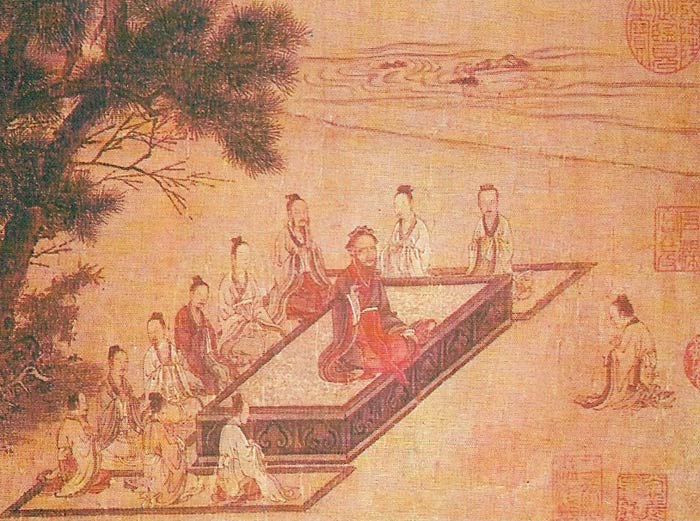
Figure 1. This painting on silk from the Ming dynasty (1368–1644) shows Confucius as the ideal teacher, the "uncrowned king". During his life, he was a tutor to the sons of aristocrats and wandered from state to state, hoping to find some rulers who would put his teachings into practice, however, he met with indifference and occasion hostility. Indeed Confucius was unrecognized in his own lifetime as a moral teacher except by his small band of disciples.
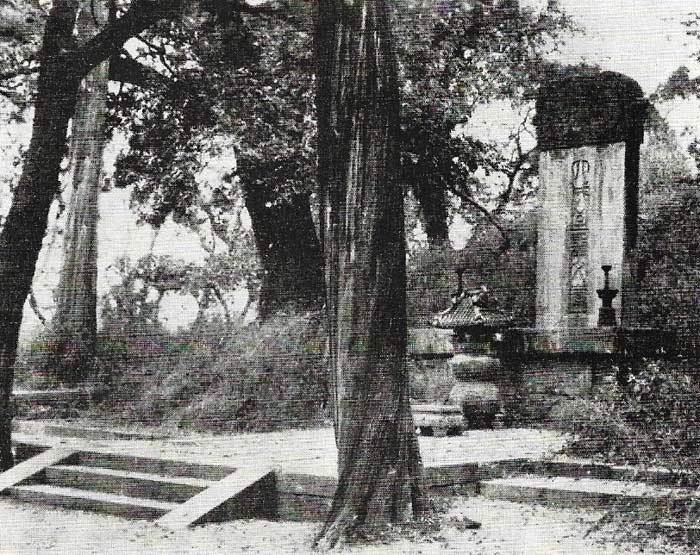
Figure 2. The tomb of Confucius can still be seen at Chufu, in the province of Shantung. In front of the tomb stands a stone tablet and alter with candlesticks and incense vessels. The tablet bears a simple inscription: "Ancient Most Holy Teacher".
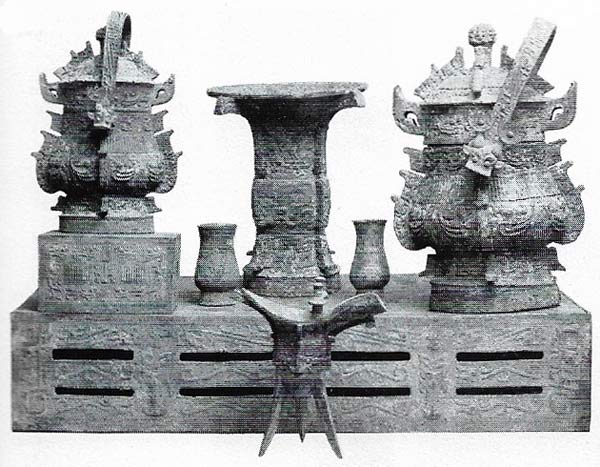
Figure 3. Bronze ritual vessels were used in sacrifices and ceremonies from ancient times. These vessels, grouped on or around the altar, bore stylized designs and masks. Their inscriptions describe royal or religious ceremonies, traditions that have influenced Confucian thought.
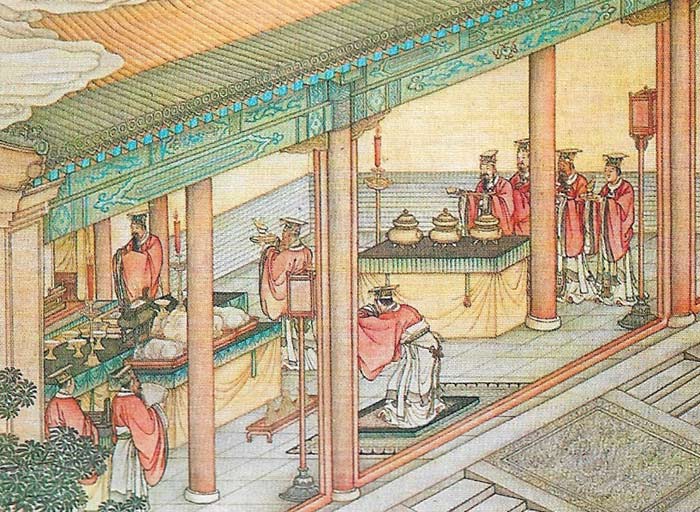
Figure 4. The offering of sacrifice and praising of the king for his laws is pictured in this illustration from the Shih Ching, a Confucian classic.
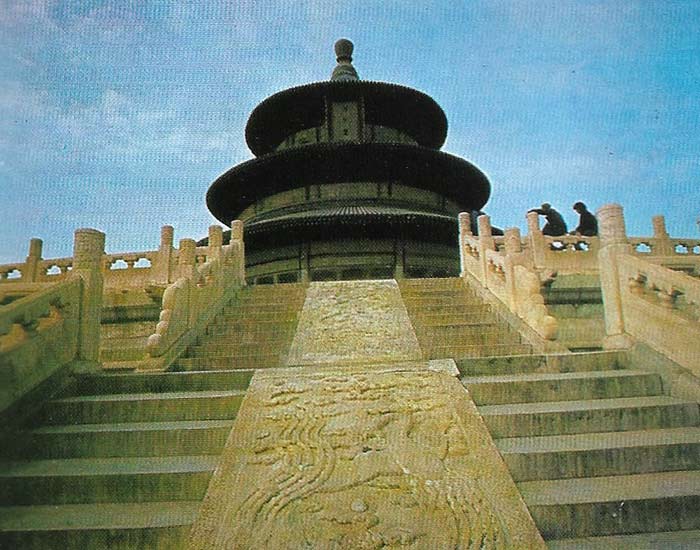
Figure 5. The temple of Heaven in Peking, with its three roofs, gold-capped shrine and blue tiles, is one of the finest buildings in China. Here the emperor himself acted as high priest for the people. It is still a national monument today.
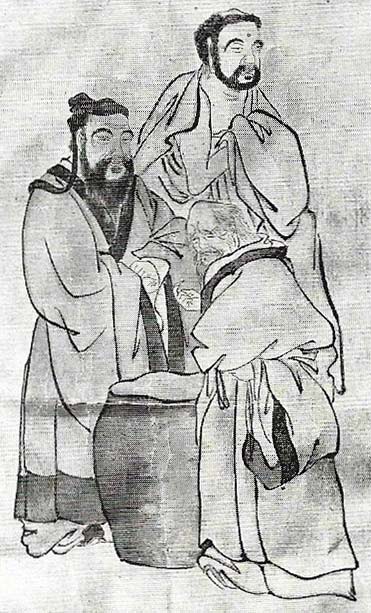
Figure 6. This fanciful picture illustrates the meeting of three ways of thought in ancient China. Confucius, left, as a scholar, may never have met Lao Tze, shown, right, as an old man, and the Buddha, as a, center, monk, may never have been to a China. But Confucian morality and ceremony, Taoist nature mysticism, and Buddhist asceticism and devotion played formative parts in the traditional structure of Chinese religion, art and social life.
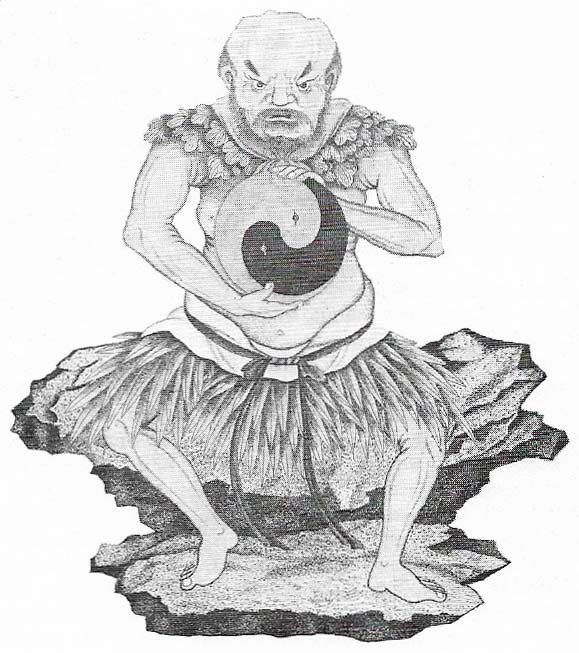
Figure 7. P'an Ku, a mythological figure, here holds the symbols of yin and yang which appear in Confucian thought.
Thousands of oracle bones which survive from the Shang dynasty (c. 1600–c. 1030 BC) give archaeologists clues to the form of religion in ancient China. From texts incised on these bones, a picture emerges of a world regulated by spirits of deceased kings (ti), ancestors, nature gods and guardian spirits. The Shang dynasty was overthrown by the Chou (c. 1030–221 BC) who believed that their dynasty had a mandate from heaven to rule the land. Heaven (T'ien) or the "supreme ancestor" (Shang Ti) was believed to govern the universe, fix the seasons, give fertility to men and animals and order the cycle of death and renewal. The emperor was also a priest who performed rituals to ensure the orderly rituals to ensure the orderly succession of nature.
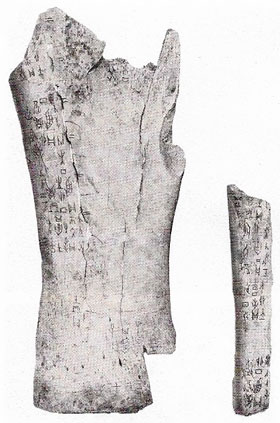 |
| Oracle bones were inscribed with questions to the spirits about the future. The bones were heated and the resultant cracks were "read". |
The life of Confucius
Documents have survived from the Chou period, which are quoted, and may even have been edited, by Confucius. They form part of the ancient tradition, which includes the complementary forces of yin and yang (Figure 7) and reverence toward heaven and ancestors (Figure 3), that Confucius inherited. Elements of Chou religion were transmitted by later Confucian teachers. Confucius is the Latinised form of K'ung Fu-tzu, Master K'ung, who was born in the city state of Lu in northern China in 551 BC and died in 479 BC. Confucius came from an aristocratic family but grew up in comparative poverty and, being disappointed in a political career, found his true work in training young men for public service.
Confucius founded his own private school, one of the first in China, and without claiming originality taught what he considered to be the best ancient wisdom. He discussed the arts of life in a city state, the study of old documents, and the Book or Poetry which included ritual hymns of early Chou rulers. But while claiming to preserve or restore earlier tradition, Confucius interpreted the documents in his own way and formulated an ethical and moral system that has influenced China ever since.
When he was about 50, Confucius was given office in the state council – some have claimed that he was prime minister of Lu – but he was dissatisfied with office and he traveled to neighboring states without success and meeting much hardship. He returned home a disappointed man and spent his last years in teaching and study.
The literature and teachings of Confucius
Confucius is traditionally credited with authorship, or at least editorship, of the five Confucian classics: the Book of Poetry, the Book of History, the Book of Changes, the Spring and Autumn Annals, and the Book of Rites, but few of these writings can be safely attributed to him. His true teachings are contained in the Analects (Lun-yu), a small book of his sayings recorded by his pupils. Modern specialists consider that some of these chapters are not authentic, but they are traditionally held to be words of the Master. The Analects teach a way of goodness (jen) which includes courtesy, loyalty and unselfishness. Rulers should seek it, but it is almost a saintly quality. The ideal prince should rule by goodness and govern his conduct by ritual (li). This ritual is not confined to religious worship but is concerned with dress, good manners and personal morality. Confucius described this as the Way of the True Gentleman and it is his ideal. He also advocated filial piety (hsiao) to parents and ancestors and proposed a hierarchy of relationships: ruler and subject, father and son, older and younger brother, husband and wife, and friend with friend. Confucius believed in the Supreme Being, but held that service to God is meaningless if service to man is neglected.
Confucius and his contemporary Lao Tze (c. 604–532 BC) were teachers rather than founders of religions, but their supposed writings became sacred scriptures of Confucianism and Taoism respectively, and part of the whole culture of China (Figure 6). The teaching of Confucius was continued and extended later by Mencius (372–289 BC) and Hsun Tzu. Within a few centuries Confucian teachings became the orthodox doctrines of the state and the guiding lines of the official classes.
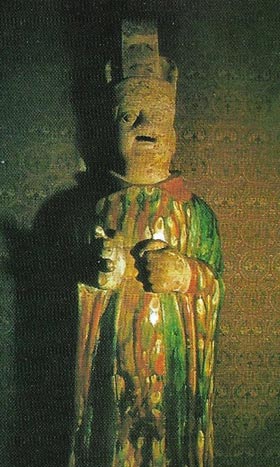 |
| Court officials in China, such as this mandarin, even before the beginning of the Christian Era were appointed to study the Confucian classics. Eventually the study of these works became universal among the educated classes and examinations in them had to be passed before service to the state could be undertaken or promotion gained; eventually a large Confucian-trained bureaucracy developed. |
The role of Confucius in history
Confucius was neither a god nor a prophet, and it is often asserted that Confucianism is not a religion, but this statement should be qualified in order to be properly understood.
Before the Christian era, emperors offered sacrifice at the tomb of Confucius (Figure 2) – a practice that continued for many centuries. Yet Confucius was not a god with images but an ancestor or great sage, revered at the Teacher of Ten Thousand Generations. Nevertheless, the tradition of Chinese veneration of ancestors and Confucius' own emphasis on filial piety led to ancestral ceremonies being associated with Confucianism. The role of the emperor, and his performance of rituals on behalf of the people (Figure 4), further added to the complexities of Confucianism as did the moral and social teaching of Confucius himself.
In modern times Confucius has been alternately attacked as a feudal aristocrat and revered as the greatest teacher of ancient China. The dead are still venerated in China, and much time and money continue to be spent on preserving temples (7) and graves. Modern China, despite the shift away from tradition, brought about by the Marxist ideals practiced by its rulers, still continues to be profoundly influenced by Confucianism.
